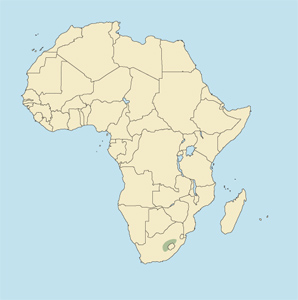 |
Connochaetes gnou
Nu negro (Sp), Weisschwanzgnu (G), Gnou à queue blanche (F), Swartwildebees (Af). Also called white-tailed wildebeest or white-tailed gnu. The name "black wildebeest" is well established, though the animal is not really black. It does, however, appear black at a distance and is darker than its relative the common wildebeest. The name wildebeest was given it by early Dutch settlers in South Africa who regarded it as a wild ox. "Gnu" is a Hottentot word that describes its characteristic bellowing snort.
DESCRIPTION Shoulder height 45-47 inches (114-120 cm). Weight 350-400 pounds (160-180 kg).
The black wildebeest is a large, dark brown antelope of grotesque appearance. The shoulders are massive and somewhat higher than the slender hindquarters. The head is large, with a long face that is covered by a brush of stiff hairs pointing upward. There is a beard under the throat, a tuft of hairs between the front legs, and a stiff buff-and-black mane on the neck and shoulders. The tail is long and white, nearly reaching the ground. The horns (both sexes) form bosses, grow outward and downward, then bend forward and sharply upward. Females are similar to males, though a little smaller, and their horns are slimmer.
BEHAVIOR Gregarious. Females and juveniles form herds of up to 20-30, which are herded by territorial males during the rut but disregarded at other times. Territorial males are attached to their territories year-round, becoming aggressive during the mating season and fighting other males fiercely. Bachelor males form their own loose associations. A seasonal breeder, with births taking place during the summer after 8-1/2 months gestation. The single calf stays with the mother until the birth of the next one. Lifespan up to 20 years.
Active morning and afternoon, resting in the open during the day and not seeking shade. Mainly a grazer, often kneeling to do so. Will browse on chary bushes in winter. Dependent on water. Eyesight and hearing are excellent, sense of smell is good. Can run at a good speed. Defends itself bravely when attacked. At times, will snort, buck, kick and caper about in a demented manner-has been called the "clown of the animal kingdom." Black wildebeests have the reputation of being untrustworthy and dangerous in captivity. Their call is a loud bellow that sounds like "genu."
HABITAT Open grasslands.
DISTRIBUTION Black wildebeests were once found throughout the entire central plateau of South Africa in vast numbers; however, they were nearly exterminated from overhunting and agricultural development by the beginning of this century. Today, through the efforts of government and private individuals, the species is out of danger, and has been re-established on reserves and private ranches in many parts of South Africa. Also introduced outside its natural range on private ranches in Namibia and Zimbabwe.
REMARKS As they live on open plains, black wildebeests are not hard to locate, but approaching them and determining sex and horn size may be difficult, especially in areas where they are regularly hunted. Often there is little cover, and long shots may be required.
TAXONOMIC NOTES No subspecies are recognized.
|





